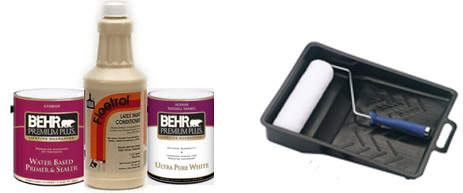Painting Instructions
The shiny side of curtain blackout material has a gain of around 1.0 (ie: the same amount of
light is that hits the screen is reflected back). Below are instructions
for increasing this gain slightly to somewhere around 1.1-1.2 by painting
the surface. The end result is a screen, that when viewed directly on axis,
appears to have close to the same gain as Stuart/Draper/DaLite 1.3 screens (for a
fraction of the cost).
Complete screen-painting instructions are as follows:
Materials needed:
1) 1 quart of Behr latex primer.
2) 1 bottle of Floetrol, a paint additive/thinner designed to get paint to flow more
evenly. (Buy at:
Amazon.com)
3) 1 quart of Behr Ultra Pure White eggshell (#2050).
4) Rollers with smallest pile possible (get very thin felt like covers if
possible). This will help ensure that the paint is put on smoothly. Also buy
plenty of these. i.e. Don't try and reuse the one from the primer paint for the
top coat.

(Using our affiliate links helps support our site at no additional cost to
you. We thank you!)
Painting steps:
1) Set-up your painting area. This might sound like a silly step. But to get
an even coat, plan to paint well past the board surface. Use a nice big drop
cloth or whatever it takes. I would also plan to stand above the board with the
board laying flat on the ground. Then use a roller on a long handle paint while
looking down.
2) Apply the latex primer. Getting a perfect coat here isn't crucial, but
this is a good time to perfect your stroke with the roller. Lifted the screen up
and leaned it on a wall with the viewable surface to the inside to let it dry
and avoid having dust settle on the wet surface. You'll get a a lot more dust &
fibers if you just leave it lying on the ground. I covered up the roller & tray
with a plastic bag, waited an hour then applied the 2nd coat of primer. Then
left it for the
night to really dry properly before applying the actual paint the next day.
3) Mix the Behr with the Floetrol in about a 6:1 ratio.
4) Start painting. Make sure not to start and/or stop anywhere on the
surface. Only start or stop off the surface on the drop cloth or newspaper. Plan
to do about 4+ coats. The thinner and more even you make the coats the smoother
the final product will be. Apply very little paint at a time and let the weight
of the roller do most of the work. After each coat, lift the screen up and lean
it inwards against a wall to let it dry for an hour or two. (Cover up the roller
and paint in the meantime). I was able to do a couple of coats per roller this
way. Did 2 coats/day for a total of 6 coats. Use a new roller each day.
You're done!
When you do get your final product, I think you will be able to achieve close
to a 1.1-1.2 gain with a completely white (cleanable) surface. If you want something above 1.3 gain you're probably going to have to buy
professional screen material (though under 1.5 is recommended for traditional
CRT projector screens to avoid hot-spotting and colour shifting).
| Did you find this information useful? Please consider making a
donation to help defray the cost of managing and hosting future
articles, tips, and documents. |
|
|
|
Or
purchase
from
Amazon.com
and a small percentage automatically
goes to support this site at no extra cost to you! Visit their
Blu-ray and
4K UHD
stores for sales.
Want to show off your
home theater? See our
Blu-ray Release List & Must-Have Titles. |
|

|
|

|




